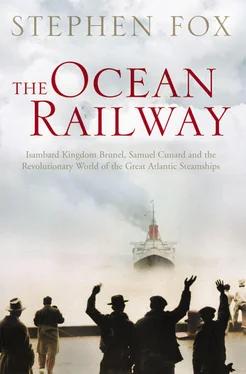To meet and perhaps subdue this most difficult natural environment: the peerless shipbuilding and marine engineering along the River Clyde, where most of the finest Atlantic liners of the nineteenth century would be designed and built.
The magical, transforming element of steam, the universal microchip of this era, and the utopian hopes of abolishing time and space it inspired.
The touchy ties among nations, especially between Britain and America, and the additional utopian hopes of international reconciliation forged by regular steamship service.
The stratifications of class and duty among the ship crews: officers and men, sailors and engineers, canvas and coal, above and below decks.
The recurring public wonder over every successive version of the newest, biggest, fastest steamship on the ocean, each likely to be described in turn as ‘a floating palace’.
And at the centre of it all, driving and organizing, the elusive figure of Samuel Cunard and the great transatlantic steamship line he founded.
PART ONE: The Packet Ship Era, 1820-1840
Before steamships started crossing the North Atlantic, the best way to travel between Europe and America was by the sailing ships called packets. Built and run mainly by Americans, the packet linesintroduced new concepts and comfort levels for ocean voyages. They dominated the transatlantic traffic for decades, setting key precedents for the steamships that eventually replaced them. Along with their more famous contemporaries, the whaling and clipper ships, they comprised the golden age of American sail. Of these three types, the packets lasted the longest and made the most voyages and money for their owners and crews. Yet today whalers and clippers remain drenched in popular legend, while the packets are scarcely known beyond dedicated circles of ship buffs. No packet builder ever became as famous as Donald McKay with his clippers, and no novelist ever wrote a Moby Dick about the packets. They just did their jobs quietly and well, year after year, and then passed into the historical obscurity reserved for predictable competence.
Agroup of textile importers in New York started the first packet line. The main founder, Jeremiah Thompson, was an English immigrant from Yorkshire who had come to New York aged seventeen in 1801 to join his uncle in representing the family’s woollen manufacturing business. From that base they engaged in shipping and shipowning with three local associates. These five men all lived near the waterfront at the southern tip of Manhattan. Four of them were Quakers. (Jeremiah Thompson, an active Friend, was an officer in the New York Manumission Society, dedicated to freeing slaves; but he also made a fortune by exporting raw cotton, grown in the American South by slave labour.)
Thompson had a breakthrough idea for improving ocean travel. At the time, a shipowner might advertise a ship’s day of departure, but the captain would then wait until enough cargo and passengers had been loaded, and wind and weather seemed favourable, before weighing anchor. A passenger hoping to embark might have to hang around the docks, spending money on food and lodging and wasting time, for a week or more. Thompson, dealing in volatile markets for finished imports and raw exports, wanted faster, more reliable service. He conceived the notion of a transatlantic ship ‘line’: several vessels under coordinated private management, sailing on known dates between established ports, and locked into an unchanging departure schedule for the foreseeable future.
In the autumn of 1817, the Thompsons and their three associates placed a notice in New York’s newspapers. ‘ In order to furnishfrequent and regular conveyances for GOODS and PASSENGERS,’ they announced, ‘the subscribers have undertaken to establish a line of vessels between NEW-YORK and LIVERPOOL, to sail from each place on a certain day in every month throughout the year.’ They listed the line’s first four ships: three-masted and square-rigged, and larger than average size for their time at around 110 feet long and 400 tons. The Pacific,launched in 1807 and the oldest of the four, was especially fast; earlier that year she had made a run to Liverpool in only seventeen days. ‘ These shipshave all been built in New-York, of the best materials,’ the owners asserted. ‘They are known to be remarkably fast sailers, and their accommodations for passengers are uncommonly extensive and commodious.’ Thompson and his partners were promising a daring combination of speed, comfort and predictability – qualities previously unknown on the North Atlantic.
The first two ships of the line sailed from New York and Liverpool in January 1818. For identification they showed a large black ball painted on their fore topsail, at the highest point of the first mast. The ‘Black Ball Line’ at once earned a tight reputation for minding the calendar. Fighting winter gales, the Pacific made a slow return trip to New York of forty-eight days; she was then unloaded and reloaded in an impossibly short six days and left for Liverpool as scheduled on the fifth of April. Later that year, the Black Ball’s Courier on leaving Liverpool met the Pacific coming in, and when approaching New York met the Black Baller Amity going out. The line added more ships, allowing two sailings a month each way. For any eastbound trip under twenty-two days or westbound run under thirty-five, Jeremiah Thompsongave the captain a new coat, with a dress for his wife. After two years, even Niles’ Weekly Register, from the rival port of Baltimore, had to concede that the Black Ball ships were running with the speed and almost the regularity of a horse-drawn mail coach. ‘ Such steadinessand despatch is truly astonishing,’ said the Register, ‘and, in a former age, would have been incredible.’
Success brought competition. Atlantic packetlines started running from Philadelphia and Boston. Early in 1824, the Boston line’s Emeraldcaught a rare easterly gale and rode it all the way home from Liverpool in an astonishing seventeen days, a westward record for years. In New York, the Red Star and Blue Swallowtail lines competed directly with Black Ball. Other new lines ran to London and to Le Havre on the northern coast of France. The sharp rivalry among all these lines added another new concept to transatlantic travel. Ship technologies in Europe and America had been essentially static for some two hundred years; conservative builders and owners resisted innovations and kept turning out the same old models. Packet competition kicked ship design into the progressive nineteenth century. Constructed mainly in shipyards along the East River in New York, ever bigger and fancier, the new packetsbecame the largest and finest ships yet built in America, evolving more quickly than any other type of vessel.
Black Ball set the initial pace. The Canada, 132 feet and 525 tons, was launched in March 1823. ‘ We have neverexamined a ship which was in all respects equal to her,’ said a local newspaper. Her dining cabin offered polished mahogany tables and pillars, sofas, and plush crimson draperies. The men’s cabins, brightened by skylights of ground glass in the main deck overhead, had olive-coloured damask silk curtains. In the ladies’ cabins the curtains were fine blue silk. A year later, the Blue Swallowtail Line answered Black Ball with its own York. To the now-expected mahogany woodwork, the York added a library with a printed catalogue, redwood pillars finished in imitation bronze, and venetian blinds in the cabin doors that allowed ventilation with privacy. Cabin washstands doubled as desks. A Turkish carpet covered the floor and muffled shipboard sounds. The ladies’ lounge even featured a small piano flanked by large mirrors. ‘ In the comfortand entertainment which the American ships afford,’ a Liverpool newspaper’s account of the York acknowledged, ‘…their superiority over British vessels is most conspicuous.’
Читать дальше












